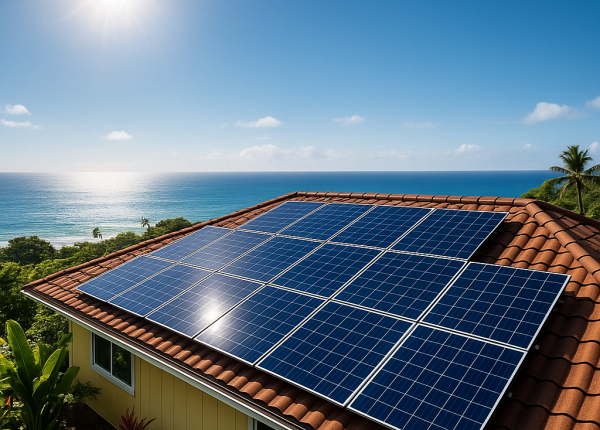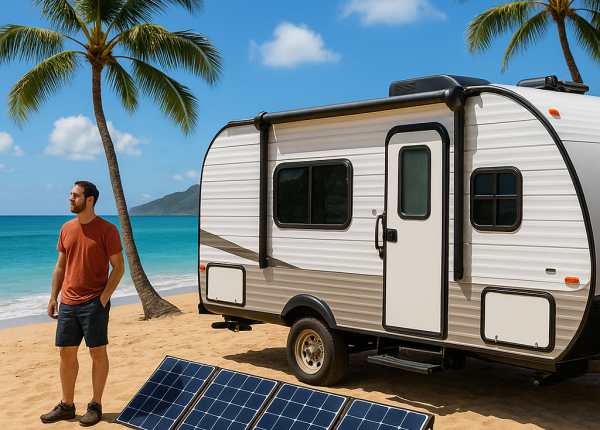What Is Solar Energy and How It Works in Hawaii
The Hawaiian Islands are world-renowned for their breathtaking landscapes, golden beaches, and year-round sunshine. But that same abundant sunshine offers something even more valuable: solar energy, a renewable power source transforming how Hawaii’s residents and businesses generate electricity.
As the world faces rising energy costs and growing concerns about climate change, solar energy has become one of the most efficient and sustainable solutions. In Hawaii, where electricity rates are among the highest in the United States, harnessing the sun’s power provides both financial savings and environmental protection.
In this article, you’ll learn what solar energy is, how it works, and why it’s one of the smartest energy investments for Hawaii homeowners and businesses today.
Understanding Solar Energy: The Basics
Solar energy is the radiant light and heat from the sun that can be captured using technologies such as photovoltaic (PV) panels, solar thermal systems, and solar concentrators. Every hour, the sun emits enough energy to power the planet for an entire year, according to NASA. This makes solar energy a renewable and nearly limitless resource for Hawaii and beyond.
The Science Behind Solar Energy
At its core, solar energy is based on the photovoltaic effect—when sunlight strikes certain materials like silicon, electrons are knocked loose, creating an electric current. This principle allows solar panels to convert light into electricity. The U.S. Department of Energy explains that the process can achieve high conversion efficiencies depending on cell type and sunlight conditions (Energy.gov).
Types of Solar Energy Systems
Photovoltaic (PV) Systems
PV systems convert sunlight directly into electricity. They’re widely used for residential, commercial, and industrial power generation. Explore the latest PV options through Alternate Energy Hawaii’s photovoltaic solutions.
Solar Thermal Systems
These systems capture sunlight to heat water or air, commonly used for solar water heating in Hawaii. Solar thermal technology is an affordable and efficient way to reduce energy bills while lowering carbon emissions.
Concentrated Solar Power (CSP)
CSP systems use mirrors to focus sunlight onto a receiver, producing heat that drives turbines to generate electricity—an approach well-suited for large-scale operations, as noted by NREL.
From kit solar energy setups to advanced commercial installations, the adaptability of solar technology makes it essential to Hawaii’s clean energy future.
How Solar Energy Works: Step-by-Step Explanation
Understanding how solar energy works helps homeowners and businesses appreciate its simplicity and innovation. Here’s how sunlight becomes usable power:
- Sunlight Hits the Solar Panels: Solar panels, made of silicon-based cells, absorb photons from sunlight, freeing electrons to generate energy.
- Creation of Direct Current (DC) Electricity: The movement of electrons generates direct current (DC) electricity.
- Conversion to Alternating Current (AC): A solar energy inverter converts DC to AC, making the electricity usable in homes and compatible with the grid. Learn more about ac solar energy technology on Energy.gov.
- Powering the Home or Business: The converted energy powers household appliances like solar energy fridges, solar energy flashlights, and solar energy street lights.
- Net Metering in Hawaii: Hawaii’s Smart Export and Battery Bonus programs by HECO reward homeowners for feeding excess electricity back into the grid, providing credits on their bills.
- Energy Storage for Night Use: Advanced solar energy banks and batteries, like Tesla Powerwall or LG Chem, store excess electricity for later use, providing energy security during outages. Discover more about storage systems at Alternate Energy Hawaii’s PV storage solutions.
The Benefits of Solar Energy in Hawaii
Hawaii’s abundant sunlight and high utility rates make solar energy both environmentally and economically advantageous.
1. Substantial Cost Savings
Electricity in Hawaii costs nearly triple the U.S. average. Solar panels can cut bills by up to 80%. According to Forbes, the average homeowner in Hawaii saves tens of thousands of dollars over a system’s lifespan.
2. Energy Independence
Solar energy in Hawaii empowers residents to produce their own power and rely less on imported fossil fuels. Pairing solar panels with energy-efficient air conditioning (learn more) further boosts self-sufficiency.
3. Environmental Impact
By reducing greenhouse gas emissions, solar energy helps combat climate change and protect Hawaii’s fragile environment. The National Renewable Energy Laboratory (NREL) confirms that solar power has one of the lowest life-cycle carbon footprints among all energy sources.
4. Increased Property Value
Homes equipped with solar energy systems and high-quality roofing (view roofing options) often sell faster and at higher values. Buyers appreciate the long-term cost savings and sustainability benefits.
5. Government Incentives
Hawaii residents benefit from the 30% Federal Solar Tax Credit, up to 35% Hawaii State Tax Credit, and other local rebate programs. These incentives make transitioning to solar energy more affordable and appealing.
Real-World Examples: Solar Energy in Action Across Hawaii
From Oahu to Maui, solar energy is revolutionizing the islands’ power landscape:
- Residential Success Story: A Honolulu homeowner installed a 10-kilowatt rooftop system and cut their electric bill from $400 to $30 per month.
- Commercial Transformation: A Maui resort partnered with Alternate Energy Hawaii to install solar panels and storage, reducing energy costs by 60% while attracting eco-conscious guests.
- Community Projects: The Kauai Island Utility Cooperative (KIUC) now produces over 60% of its electricity from renewable sources, primarily solar energy—a model highlighted by Statista for its innovation and impact.
Expert Insights and Best Practices for Going Solar
Before making the switch to solar energy, consider these expert tips:
Assess Your Energy Usage
Review past electricity bills to determine how much energy a solar panel can generate for your needs.
Evaluate Roof Orientation and Condition
South-facing roofs capture the most sunlight. Ensure your roofing is in good condition prior to installation.
Choose a Reputable Installer
Work with trusted experts like Alternate Energy Hawaii, who specialize in electrical services and understand local climate and regulations.
Incorporate Energy Storage
Integrate a solar energy bank or battery for round-the-clock energy independence.
Regular Maintenance and Monitoring
Schedule periodic inspections and clean panels regularly. Many systems come with digital monitoring tools to track output and efficiency in real time.
Key Takeaways: Why Solar Energy Is Hawaii’s Future
Hawaii’s plan to reach 100% renewable energy by 2045 relies heavily on solar power. With generous tax credits, decreasing installation costs, and near-constant sunlight, the islands are leading the way in clean energy adoption.
To recap:
- Solar energy converts sunlight into reliable, renewable power.
- It offers long-term savings and environmental protection.
- Hawaii’s incentives make it more affordable than ever.
- Battery storage ensures complete energy independence.
By embracing solar energy, Hawaii residents can protect their wallets, the environment, and the islands’ natural beauty—ensuring a sustainable legacy for generations to come.
FAQs About Solar Energy in Hawaii
1. How long do solar panels last in Hawaii?
Typically 25–30 years, with performance warranties ensuring efficiency over time.
2. Does solar work on cloudy days?
Yes. Panels generate electricity even in diffuse sunlight, maintaining output year-round.
3. What happens to unused solar power?
Excess energy is stored or sent to the grid through net metering, earning credits on your bill.
4. Are financing options available?
Yes—Hawaii residents can choose from loans, leases, or power purchase agreements (PPAs) to make solar affordable.
5. Can solar panels handle Hawaii’s weather?
Absolutely. Panels are designed to resist salt corrosion, wind, and rain, making them ideal for island climates.
For added sustainability, explore solar water heating and electric vehicle charging solutions to complement your solar setup.


